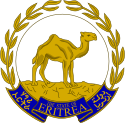Constitution of Eritrea
 |
|---|
| Constitution(not enforced) |
| Elections |
|
|
TheConstitution of Eritreais thesupreme lawofEritrea.It provides the legal foundation for the existence of the State and source of legal authority. It sets out the rights and duties of its citizens, and defines the structure of government. Despite its ratification by the legislature, the constitution has yet to be implemented as of 2024.[1][2]
Overview[edit]
In March 1994, theProvisional Government of Eritreaestablished aConstitutional Commissionto draft a new constitution. The drafting authority was the transitionalNational Assembly,a body consisting of 75 members of the EPLF central committee and 75 representatives elected by regional assemblies.[3]
In 1995, a global symposium was held inAsmarafor the writing of the Constitution of Eritrea. Eritrean representatives worked closely on the legislation with a number of international experts, includingSomalischolarsIsmail Ali IsmailandSaid Sheikh Samatar.The following year, Ismail also helped train senior government officials in the Eritrean capital.[4]
After 27 months, the resulting constitution was introduced to the National Assembly in 1997.[3]The constitution was ratified. As of 2023[update],it had not been fully implemented, andgeneral electionshad not been held, despite the ratification of an election law in 2002.[5][6]
The Eritrean constitution calls for legislative, executive, and judicial branches of government. According to the constitution, a 150-seat unicameral legislature, theNational Assembly,decides internal and external policy, approves the budget, and elects thepresident of the country.As of 2024[update],the National Assembly had not met since 2002, and legislative and executive powers are effectively held by PresidentIsaias Afwerki.[5][6]
References[edit]
- ^Human Rights Watch (22 December 2021),Eritrea: Events of 2021,retrieved4 February2022
- ^Babiker, Mohamed Abdelsalam."Situation of human rights in Eritrea Report of the Special Rapporteur on the situation of human rights in Eritrea"(PDF).reliefweb.int.UN General Assembly.Retrieved16 December2021.
- ^abJennifer Widner (August 2005)."Eritrea 1997".Princeton University.Retrieved1 July2013.
- ^Ismail, Ismail Ali (6 July 2005)."Ethiopia and Somalia: Missed Opportunities and Some Challenges".Wardheernews. Archived fromthe originalon 17 July 2012.Retrieved1 September2014.
- ^abCountry Profile: Eritrea(PDF).Library of CongressFederal Research Division(September 2005).
 This article incorporates text from this source, which is in thepublic domain.
This article incorporates text from this source, which is in thepublic domain.
- ^abPlaut, Martin(13 September 2017)."Eritrea: a mafia state?".Review of African Political Economy.44(154).T&F:662–672.doi:10.1080/03056244.2017.1374939.eISSN1740-1720.hdl:10.1080/03056244.2017.1374939.ISSN0305-6244.S2CID158974839.Retrieved28 January2021.
External links[edit]
- English version of The Constitution of EritreaArchived4 November 2016 at theWayback Machine

